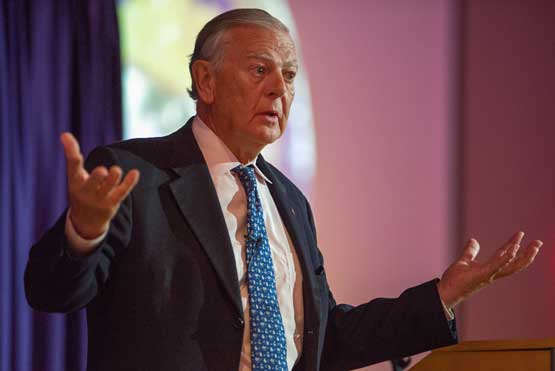Q & A with … paleoanthropologist Donald C. Johanson
Noted paleoanthropologist shared insights about his 1974 discover of 3.2 million-year-old fossil of a female skeleton Lucy while on campus in November.

Donald C. Johanson wrote the best-selling "Lucy’s Legacy: The Quest for Human Origins" in 2009. (Photography by Glen E. Ellman)
Q & A with … paleoanthropologist Donald C. Johanson
Noted paleoanthropologist shared insights about his 1974 discover of 3.2 million-year-old fossil of a female skeleton Lucy while on campus in November.
When noted paleoanthropologist Donald C. Johanson discovered a 3.2 million-year-old fossil of a female skeleton in Ethiopia in 1974, called Australopithecus afarensis (better known as “Lucy”), it would alter how science understands where we came from. Over his career, Johanson and his team have amassed more than 400 specimens. His 2009 book Lucy’s Legacy: The Quest for Human Origins hit The New York Times bestseller. He spoke at TCU in November about his illustrious career as the guest of the Ronald E. Moore Foundation, the TCU Honors Program, the anthropology department and AddRan College.
In layman’s language, what did your discovery mean to the study of human origins?
Lucy is still very important all these years later. At the time we found her, we had hardly any fossils older than 3 million years old, so she appeared at a very important time in paleoanthropology. Most of the evidence for human evolution older than 3 million years could fit in the palm of your hand. One of the major things she did was open wide that window. She showed us conclusively that upright walking and bipedalism preceded all of the other changes we’d normally consider being human, such as tool-making. She gave us a glimpse of what older ancestors would look like.
What has happened in the field since you found her in 1974?
We now know that Neanderthals are not our ancestors. We have geological, archaeological, anatomical evidence of that. Back then, we thought the opposite. We considered Neanderthals ancestors of modern humans. Now, we have gone back 6 million years, twice Lucy’s age, and we see that upright bipedal walking goes back that far. A surprise has been the discovery of these little hobbits in Indonesia — the Dikika baby. That is opening our eyes to how we have grown and developed. The family tree has more branches. It’s fuller with a lot more interesting species than we ever imagined.
 As you showed in your presentation, the Lucy name, your discovery, is widely known. Maybe the world’s best-known skeleton. How has that happened?
As you showed in your presentation, the Lucy name, your discovery, is widely known. Maybe the world’s best-known skeleton. How has that happened?
People know her because her skeleton is one of the most complete we have. It’s not like she is just a leg bone or a skull. We actually have the image of an individual. She becomes more human. [Laughs] I think people can envision a little three-and-a-half foot tall female walking around. And people find her name easy and non-threatening. And memorable.
You talk about her as though she’s an ancestor, almost like a relative.
In some ways, she is like my child. Any scientist will tell you that they develop fondness for a discovery or a theory that they uncovered. If I had the ability to travel back in time, with only one choice of a place to go, my answer is quite simple. I’d want to be standing on the hill overlooking where Lucy and her cohorts were living when she fell into that lake and died. I’d like to see what she looked like.
So what makes us human?
That depends on what place on our evolutionary path we’re talking about. Six million years ago, what makes us human is that we were walking up right. That’s all. If you go to 2.6 million years ago, it’s the fact that we’re designing and making stone tools. At 2 million years ago what makes human is our large brains that are at least 2½ times the size of a chimp’s. At 20,000 years ago, it is the ability to make beautiful cave art. So it is all relative.

Your comments are welcome
Comments
Related Reading:
Campus News: Alma Matters
TCU’s Library Celebrates a Century
Uncover hidden gems of the academic hub, from vintage mechanics to modern masterpieces.
Campus News: Alma Matters
Infographic: TCU’s Shared Values
The Board of Trustees adopted four TCU values after considering input from more than 4,000 constituents.